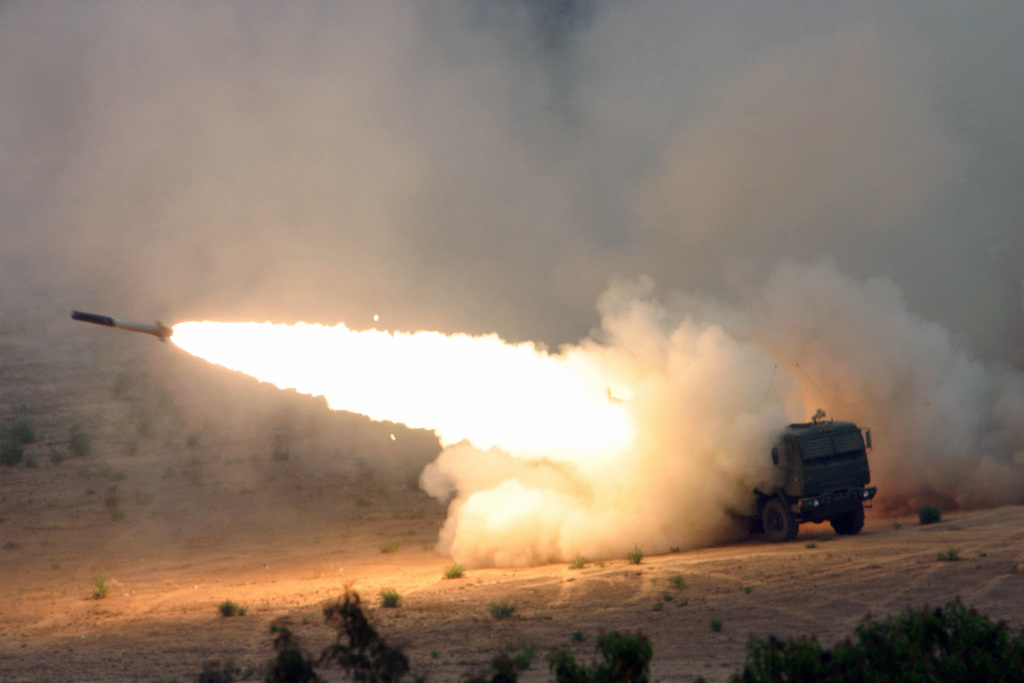Recently the media have reported that Ukrainians were consulting with Americans picking targets for HIMARS/MLRS attacks. Some commentators argue that Poland is making a mistake by investing in such weapons, because it will not be able to use them independently. This is nonsense – writes Mariusz Marszałkowski, editor at BiznesAlert.pl.
CNN reported, citing anonymous U.S. and Ukrainian sources, that Kyiv was consulting with the U.S. on the selection of targets for HIMARS/MLRS attacks. It has been alleged that Americans do not allow the independent use of „made in the USA” equipment, which would undermine the point of buying arms from that direction.
What is HIMARS/MLRS?
In the summer of 2022 Ukraine started to receive long-range missiles from NATO countries. As it turned out later, they became a kind of a game changer, as they opened the way for Ukraine to conduct its own offensives on the territories occupied by Russia, including in the Kharkiv, Luhansk and Kherson oblasts. First, the missile systems were handed over by the Americans, then the British, Germans, and then Norwegians and the French joined the game. The Americans gave Ukraine HIMARS systems on M1142 Oshkosh wheeled missile launchers, the rest of the countries donated various local upgrades to the tracked MLRS system. The difference between the two de facto identical systems is the carrier and the launcher itself. In the case of the MLRS, we have a double launcher, accommodating 12 missiles of the M26/31 family. The HIMARS, is a single, six-barrel launcher. It is much more mobile, faster, but has less firepower. The MLRS is heavier, armored, mounted on a tracked chassis with better traction parameters, but much slower. However, a single launcher replaces two wheeled HIMARS launchers.
An automatic loading system is a huge advantage in both systems. Missiles for the launcher are packed in special, six-missile modules. The launcher is not loaded like in the old Soviet systems where every missile was added individually. Instead a special lift is installed in the launcher, which changes the entire module at once. This greatly shortens and facilitates both the reloading time and the transport of the missiles themselves.
However, the launcher itself is not innovative. Ukraine has many different missile artillery systems. From the most popular 122 mm GRAD systems, through 220 mm Uragan, or the 300 mm Smerch. Contrary to the above systems, the HIMARS has a range of over 80 km and an accuracy of up to 5 meters at the maximum range. The BM-30 Smerch can fire at comparable or even greater distances, but its accuracy is questionable. In addition, the HIMARS uses six missiles to destroy targets that would require the BM-30 (12 barrel launcher) to shoot 4-8 salvos. All thanks to the missiles used in the MLRS/HIMARS kits, or GMLRS. The GMLRS (Guided Multiple Launch Rocket System) is a family of guided missiles dedicated to the HIMARS and MLRS missile systems. The range of the warhead is 84 km for the standard distance, and 150 km for the ER version. The GMLRS can be equipped with shrapnel-shattering heads, so-called Unitary, which is used to attack, for example, buildings, ammunition depots and fortified points, but also with the Alternative Warhead, which is a modern replacement for cluster munitions. GMLRS-AW contains more than 180 thousand tungsten balls, which after the explosion of the warhead a few meters above the ground are scattered at distances of up to several hundred meters. This ammunition was created to solve the problem of unexploaded misfires from conventional cluster munitions, which are dangerous for civilians. Thanks to this solution, American missiles do not leave unexploded ordnance, but at the same time they destroy the attacked target territorially. This type of a warhead is used mainly in counterattacks (against enemy artillery positions), attacks on air defense positions, radars or concentrations of enemy manpower.
However, in addition to having modern effectors that allow long-range strikes, it is also necessary to have systems capable of detecting and making a reconnaissance of the position of the enemy. The missiles for HIMARS/MLRS systems are very expensive (USD 150-200 thousand per a warhead – a set of six means one attack costs USD 0.9-1.2 million), so except for the attack itself its efficiency is also crucial. The HIMARS missile artillery system is a weapon of operational importance. As a rule, it is not used to attack in the manner known from classical artillery. The GMLRS attacks are intended to affect a broader spectrum of warfare, such as paralyzing enemy logistics by destroying bridges and crossings, attacking command centers, communications hubs, ammunition depots, and concentrations of equipment and manpower – in short, all valuable targets far behind the front line. The addition of the HIMARS into the equipment of the Armed Forces of Ukraine and their mass use in the summer of 2022 forced the Russians to move their valuable assets beyond the range of this system, more than 80 km from the front line. This made it more difficult for Russians to manage the logistics of, among others, ammunition and decreased the frequency of Russian artillery strikers. Ukraine’s ability to attack airports occupied by Russians meant that helicopters and aircraft had to carry out support operations from further away, which extends the duration of the mission and inhibits their ability to carry weapons. It also puts the aircraft at risk of getting shot down by the Ukrainian air defence, as they need to stay longer in the danger zone. In total, Ukraine has no more than 35 HIMARS and MLRS systems, which significantly affected the combat capabilities of the Russians. The systems themselves have also become one of the main targets of the Russian military, which also absorbs certain forces and means. However, the effectiveness of the Russian military in eliminating the threat is not known. According to the Russian Defense Ministry, more than 40 MLRS/HIMARS systems have been already destroyed, but so far no evidence has been presented confirming the elimination of even a single launcher.
Ukraine itself does not have the capability of conducting long-range visual or electronic recognition in real time. Some of the coordinates are provided by pro-Ukrainian residents of the occupied territories who are also informers for the Ukrainian army. However, it is necessary to thoroughly verify the information submitted by them, which takes time. Such a solution could work for targets such as bridges, weapons storage and repair sites, or ammunition depots and fuel depots. However, based on data from personal information sources, it is difficult to make a quick attack on areas with concentrated equipment or soldiers right before the planned attack, as they may change the location at any time. Here you one needs, for example, satellite images, photos from, eg., unmanned strategic reconnaissance aircraft such as the RQ-4 Global Hawk or RC-135 electronic reconnaissance aircraft. These aircraft fly far from the front lines collecting and processing intelligence, which is later transferred to the Ukrainians. This allows the troops with situational awareness to select targets, validate them against Western sources of information, and then carry out effective attacks. Only then do systems like HIMARS make complete sense.
Also in Poland, the desire to have a large number of long-range missile systems has intensified in recent months. It is worth bearing in mind the Ukrainian experience. As a NATO state, we can count on the full support of our allies in the transfer of intelligence, but we must not forget about building our capabilities in this area. Therefore, in addition to buying military equipment, it is important to develop competence in the collection, processing and use of intelligence information from our own sources. Therefore, the contract for the purchase of observation satellites from the French Airbus or the Gladius reconnaissance and strike system from the Polish company WB Electronics should be evaluated positively. The greater the saturation of the recognition sensors, the greater the efficiency of our five hundred HIMARS.









